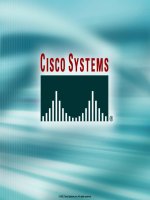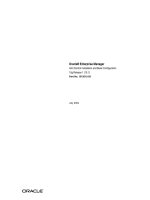Installation and Configuration
Bạn đang xem bản rút gọn của tài liệu. Xem và tải ngay bản đầy đủ của tài liệu tại đây (2.71 MB, 95 trang )
3
Installation and Configuration
Copyright © 2010, Oracle and/or its affiliates. All rights reserved.
Objectives
After completing this lesson, you should be able to:
•
•
•
•
•
•
•
•
3-2
Describe basic concepts of Oracle WebLogic Server
Explain key definitions and terminologies
Describe the prerequisites for installing Oracle Access Manager
Install Oracle WebLogic Server (WLS)
Configure seeded database schemas by using the Repository
Creation Utility
Install and configure Oracle Access Manager
Perform post-installation validation checks
Perform an uninstallation
Copyright © 2010, Oracle and/or its affiliates. All rights reserved.
Road Map
•
•
•
•
•
•
•
•
3-3
Oracle WebLogic Server: Basic concepts
Key definitions and installation prerequisites
Oracle WebLogic Server installation
Configuring seeded database schemas by
using the Repository Creation Utility
Installing Oracle Identity Management
Configuring Oracle Access Manager
Performing post-installation validation checks
Uninstallation
Copyright © 2010, Oracle and/or its affiliates. All rights reserved.
Domain: Overview
•
•
•
•
A domain is the basic administration unit for Oracle WebLogic
Server.
It always includes one Oracle WebLogic Server instance
configured as an administration server.
It may include optional Oracle WebLogic Server instances in a
domain, called managed servers.
It may also include clusters of server instances that work
together.
WebLogic Domain
Administration
Server
Managed
Server
WebLogic Server System
Administration Tools
3-4
Managed
Server
Cluster1
Managed
Server
...
Managed
Server
...
Managed
Server
Cluster2
Managed
Server
Copyright © 2010, Oracle and/or its affiliates. All rights reserved.
Domain Diagram
Domain Log
Domain
LOG
Cluster
Get configuration
at startup
Send
Critical Domain
Notifications
Console
Managed
Server 1
LOG
Administration
Server
Log Domain
Messages
GET / SET
Managed
Server 2
LOG
Monitor/
Update
Configuration
Repository
3-6
Local Logging
Local Logging
Managed
Server 3
LOG
Copyright © 2010, Oracle and/or its affiliates. All rights reserved.
Local Logging
Domain Restrictions
•
•
•
•
•
•
3-8
Each domain requires its own administration server.
A cluster cannot span multiple domains.
The managed servers in a domain must all run the same
version of Oracle WebLogic Server.
The administration server in a domain must run the same
or a higher version of the WebLogic Server software as the
managed servers in the domain.
Domains cannot share a configured resource or subsystem
between domains.
Two or more system resources cannot have the same
name within a domain.
Copyright © 2010, Oracle and/or its affiliates. All rights reserved.
Server
•
•
A “server” is an instance of weblogic.Server executing
in a Java Virtual Machine (JVM).
A server:
– Runs on a designated Oracle WebLogic Server machine
– Has a dedicated amount of RAM
– Is multithreaded
•
•
A machine can be associated with multiple servers.
The two types of servers are:
– Administration server
– Managed server
3 - 10
Copyright © 2010, Oracle and/or its affiliates. All rights reserved.
Administration Server
•
•
•
Is the central point of control for a domain
Stores the configuration information and logs for a domain
Runs the WebLogic administration console
«domain»
«machine»
config.xml
«server»
«logs»
«Admin server»
«server»
«logs»
«logs»
«machine»
«server»
«logs»
3 - 11
Copyright © 2010, Oracle and/or its affiliates. All rights reserved.
Managed Server
•
•
•
•
•
•
It is any server in a domain that is not the administration server.
It contacts the administration server for configuration
information.
It runs business applications in a production environment.
It is independent of all other managed servers in the domain
(unless they are in a cluster).
There may be many managed servers in a domain.
Individual managed servers are typically added for capacity and
«domain»
application isolation.
«machine»
«server»
config.xml
«logs»
«Admin server»
«server»
«logs»
«machine»
«server»
«logs»
3 - 13
Copyright © 2010, Oracle and/or its affiliates. All rights reserved.
«logs»
Interaction Between the Administration Server
and Managed Servers
•
•
•
•
3 - 14
The administration server stores the master copy of the
domain configuration, including the configuration for all
managed servers in the domain.
Each managed server stores a local copy of the domain
configuration file.
When a managed server starts, it connects to the
administration server to synchronize the configuration.
When the configuration is changed, the administration
server sends the changed configuration to the managed
servers.
Copyright © 2010, Oracle and/or its affiliates. All rights reserved.
What Is a Machine?
•
•
•
•
The main purpose of a machine is to administratively
manage servers.
Machines are required by the node manager.
Machines are optionally used by clusters.
A machine is a logical description, not a physical entity.
3 - 15
Copyright © 2010, Oracle and/or its affiliates. All rights reserved.
Relationship of Machines to Other Components
There are many ways to set up the topology.
«domain»
«host1»
«host2»
«NodeMgr»
«machine1a»
«host3»
«NodeMgr»
«machine1b»
«machine2»
«AdmSrv1»
«cluster»
«server4»
«server6»
«server2»
«server5»
3 - 16
Copyright © 2010, Oracle and/or its affiliates. All rights reserved.
«server3»
Cluster
•
•
A cluster is a logical group of WLS servers.
Oracle WebLogic Server (WLS) clusters provide:
– High availability (reliability)
– Load balancing (scalability)
•
A cluster is transparent to a client.
«domain»
«machine»
«machine»
«server»
«cluster»
«server»
«server»
«server»
3 - 17
Copyright © 2010, Oracle and/or its affiliates. All rights reserved.
Cluster Guidelines
•
•
•
•
•
3 - 19
A cluster cannot span domains.
All servers in a cluster must also be in the same domain.
All servers in a cluster must be at the same version level.
Clustered servers can be on the same or on different
machines with the same or different operating systems.
There can be multiple clusters in a domain.
Copyright © 2010, Oracle and/or its affiliates. All rights reserved.
WebLogic Scripting Tool (WLST)
•
The WLS command-line tools are useful:
– For automating common administration activities
– As an alternative to the administration console
– When graphical tools are not supported
•
WLST provides a command-line interface for:
–
–
–
–
3 - 20
Creating new WLS domains
Retrieving and updating WLS domain configurations
Deploying applications
Obtaining run-time server statistics
Copyright © 2010, Oracle and/or its affiliates. All rights reserved.
WLST Modes
•
Online mode:
– Available when connected to a running server
– Provides access to all WLS configuration and run-time
attributes
– Can be used to create and activate change sessions, similar
to using the WLS console
•
Offline mode:
– Available when domain is not running
– Provides access to only persisted domain configuration
(config.xml)
– Can be used to create or update domains, similar to using
the Configuration Wizard
3 - 21
Copyright © 2010, Oracle and/or its affiliates. All rights reserved.
WLST Example
[oracle@edvmr1p0 /]$ java weblogic.WLST
Initializing WebLogic Scripting Tool (WLST) ...
Welcome to WebLogic Server Administration Scripting Shell
Type help() for help on available commands
wls:/offline> connect('weblogic','password','t3://localhost:7001')
Connecting to t3://localhost:7001 with userid system ...
Successfully connected to Admin Server 'myAdmin' that belongs to domain 'mydomain'.
Warning: An insecure protocol was used to connect to the server. To
ensure on-the-wire security, the SSL port or Admin port should be used instead.
wls:/mydomain/serverConfig> cd('Servers')
wls:/mydomain/serverConfig/Servers> ls()
dr-myAdmin
dr-myserver1
dr-myserver2
wls:/mydomain/serverConfig/Servers> cd('myserver1')
wls:/mydomain/serverConfig/Servers/myserver1> get('StartupMode')
'RUNNING'
wls:/mydomain/serverConfig/Servers/myserver1> exit()
Exiting WebLogic Scripting Tool.
[oracle@edvmr1p0 /]$
3 - 22
Copyright © 2010, Oracle and/or its affiliates. All rights reserved.
Oracle WebLogic Server ILT Courses
To understand these concepts in more details and perform
Oracle WebLogic Server administration, attend:
• Oracle WebLogic Server 11g: Administration Essentials
• Oracle WebLogic Server 11g: Advanced Administration
3 - 23
Copyright © 2010, Oracle and/or its affiliates. All rights reserved.
Road Map
•
•
•
•
•
•
•
•
3 - 24
Oracle WebLogic Server: Basic concepts
Key definitions and installation prerequisites
Oracle WebLogic Server installation
Configuring seeded database schemas by
using the Repository Creation Utility
Installing Oracle Identity Management
Configuring Oracle Access Manager
Performing post-installation validation checks
Uninstallation
Copyright © 2010, Oracle and/or its affiliates. All rights reserved.
Oracle Fusion Middleware Home and Oracle
WebLogic Server Home
•
Oracle Fusion Middleware home:
– Consists of the Oracle WebLogic Server home and,
optionally, one or more other Oracle product homes (also
known as Oracle homes; such as Identity Management
home)
– Resides on a local file system or on a remote shared disk
that is accessible through NFS
– Is represented as MW_HOME
•
Oracle WebLogic Server home:
– Contains installed files necessary to host Oracle WebLogic
Server
– Is a peer of other Oracle home directories underneath the
Middleware home directory
– Is represented as WL_HOME
3 - 25
Copyright © 2010, Oracle and/or its affiliates. All rights reserved.
Oracle Home
•
Oracle home:
– Is the top-level installation directory for Oracle products
– Resides on a local file system or on a remote shared disk that is
accessible through NFS
– Is where product binaries and read-only files reside
– Contains files that are not updated during the normal running of the
application server components
—
Files are updated only when you apply a patch or upgrade.
– Is represented as ORACLE_HOME
•
Oracle instance:
– Contains all configuration files, repositories, log files, deployed
applications, and temporary files (updatable files)
– Contains one or more active middleware components, such as
OHS
– Must contain the EMAGENT component
– Is represented as ORACLE_INSTANCE
3 - 26
Copyright © 2010, Oracle and/or its affiliates. All rights reserved.
Installing and Configuring Oracle Identity
Management: Sequence of Steps
•
•
•
•
•
3 - 27
Install and configure Oracle Database
Install Oracle WebLogic Server (MW home and WLS
home)
Install Oracle Identity Management (Oracle home)
Run the Repository Creation Utility (RCU) against Oracle
Database to seed component schemas
Create or extend the Oracle WebLogic domain to configure
Oracle Identity Management 11g R1(11.1.1.3.0)
Copyright © 2010, Oracle and/or its affiliates. All rights reserved.
Wizards: Installation Versus Configuration
•
What is installation?
– Installing creates an Oracle home or WebLogic home with all
the binaries and bits of software staged.
•
What is configuration?
– Configuring creates or extends a WLS domain with new
managed servers.
– Isolates static/read-only files from dynamic/configurable
Oracle WebLogic domain files
•
•
3 - 28
Installation Wizard (IM_DVD/Disk1/setup.exe)
Configuration Wizard
(MW_HOME/oracle_common/common/bin/config.cmd)
Copyright © 2010, Oracle and/or its affiliates. All rights reserved.
System Requirements for Oracle Identity
Management 11g R1(11.1.1.3.0)
•
•
Minimum physical memory: 2 GB
Minimum available memory: 1 GB
•
Operating systems:
– Solaris 9, Solaris 10
– HP-UX 11i (11.23), HP-UX 11i (11.31)
– Oracle Enterprise Linux 4, Oracle Enterprise Linux 5, Red Hat
Linux 4, Red Hat Linux 5, SUSE 10
– IBM AIX 5.3, IBM AIX 6.1
– Windows XP SP2 (Win32 platforms only), Windows 2003, Windows
2008, Windows Vista
•
•
•
3 - 29
Temp space: At least 80 MB
Swap space: At least 150 MB
Check the latest certification and release notes before starting
the installation.
Copyright © 2010, Oracle and/or its affiliates. All rights reserved.
Road Map
•
•
•
•
•
•
•
•
3 - 30
Oracle WebLogic Server: Basic concepts
Key definitions and installation prerequisites
Oracle WebLogic Server installation
Configuring seeded database schemas by
using the Repository Creation Utility
Installing Oracle Identity Management
Configuring Oracle Access Manager
Performing post-installation validation checks
Uninstallation
Copyright © 2010, Oracle and/or its affiliates. All rights reserved.









